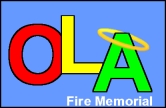|
|
Experience of Firefighter Richard A. Welch
As told to his son Robert
|
By Richard A. Welch with Robert Welch and Mary Jane Welch
|
Dad would not discuss the Our Lady of Angels school fire. Nor would he be interviewed about his experiences for books about the fire. The fire had a profound impact on him. During the final months of his life, Dad finally talked about it. This is his story, told to his son, about something that happened to the victims, their families, the city, my Dad and all of his family. This event affected all of us, as well as the fire codes across the country.
|
Richard A. Welch (Dick), our Dad, and John (Red) Windle reported to work at truck 1 (Dearborn) on December 1, 1958. They were told to pick up the new experimental snorkel (the first one ever) from the fire department garage. Commissioner Robert J. Quinn had invented the snorkel from an old lake shore drive tree trimming truck with a boom. During WWII, he had fought fires in the Navy, and saw the benefit of using a boom to shoot water down on the fire.
|
Dad and Red went to the garage at 31st and Sacramento where the final detailing that separated the black and red paint on the truck was being completed. Once there, they were told to report with the new snorkel immediately to Our Lady of Angels at 600 N. Avers; a school fire. On the way over Dad saw the column of smoke, he said the worst he had ever seen, as black as smoke can be, going straight up. When they pulled up it was complete pandemonium. No ladders could reach the windows. There was a wrought iron fence around the entire school that impeded the hoses, ladders and trucks from getting to the school. He talked about the fence often. It impeded the emergency equipment. He said if he had been there at the beginning, he would have rammed the fence with the truck. In the book, To Sleep with the Angels by David Cowan and John Kuenster, Red discussed (p.96) his fears of not being able to get in were diminished as the clogged streets were quickly maneuvered. Dad was the driver, and nothing was going to keep them from fighting the fire. The firemen were trying to rescue the children. The parents, neighbors and firemen were begging the children to jump out of the windows; they just wouldn't. Some family members and neighbors had their ladders up to get the children, but they were not tall enough and just got in the way. Dad drove right up and hooked up the hose to the truck, while Red went into bucket. Once dad got water hooked to the truck he immediately went in the building, where other firemen were already there. He ended up going to the third floor. There was no way anyone could go down the hallway. Dad was an ax man and he and the other firefighters used axes to go through wall to wall, from room to room. Once the fire was secured they began removing the child victims. He said in one room all the kids were still at their desks. Dad was the one who removed the first victim and handed him down (see picture).
|
He said that the fire was a culmination of events, which would never happen again. He believed every Chicago fireman, including those who joined after the fire, wished they were there because they believed they could make a difference. Every fireman who was there wishes they weren't.
|
One thing Dad had always acknowledged was very hard on him, as well as many of the other firemen present, were that all of the Catholic schools had the same uniforms. The girls all wore navy jumpers with the school insignia on the pocket, and white blouses and the boys wore shirt and ties. So, when the fireman saw the school on fire, with the students in their uniforms; they saw their own children. They all did everything they could possibly do, and some things they shouldn't have been able to do, in order to get all the children out; they just could not. Dad was very happy when the schools all changed their uniforms.
|
All seven of Dad's children were also greatly impacted by the fire. We had to live with his concerns.
|
All of us, even those born after the fire, were constantly drilled, “You find your exit path, no matter where you are.. .figure it out, think windows, gutters, rainspouts. Do not be where there is not a way out.&rdqoo; To this day, we all still plan our escape, wherever we are.
|
We were all taught how to survive in a fire. However, we were also taught what to do when all is lost. “The kids, didn't die by the flames, nor by the smoke. The air was so superheated it sheared their lungs. If you will not be able to survive, then turn toward the fire, say an act of contrition and take a deep breath.....
|
|
|
